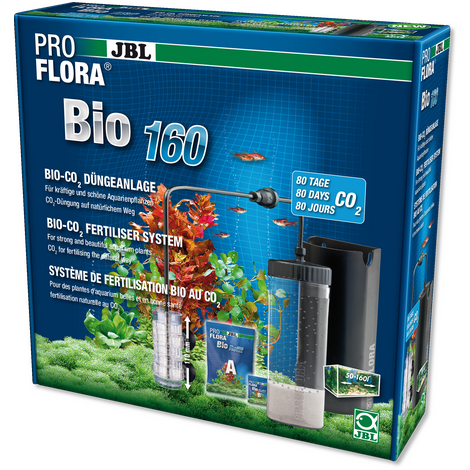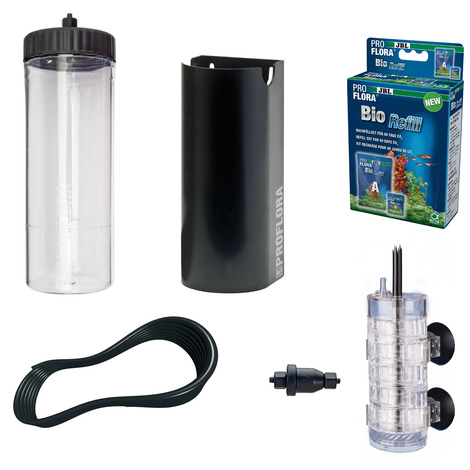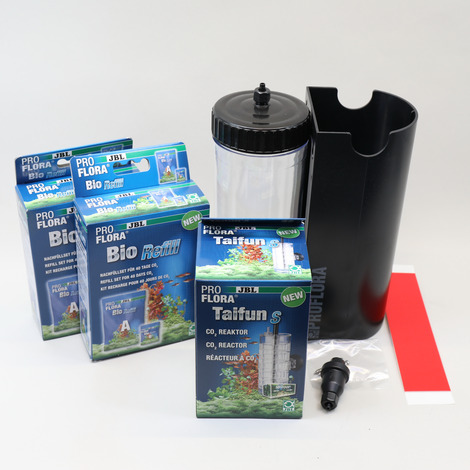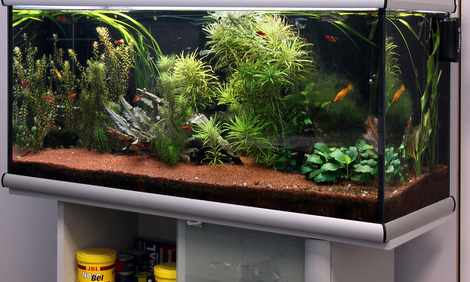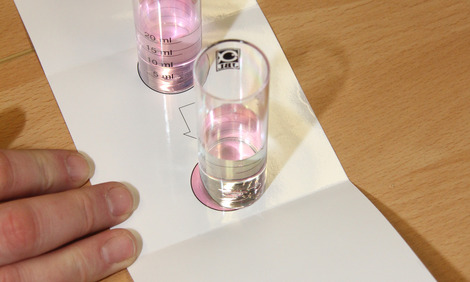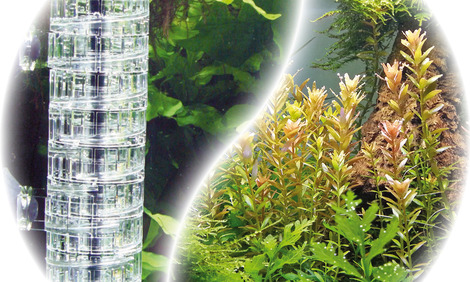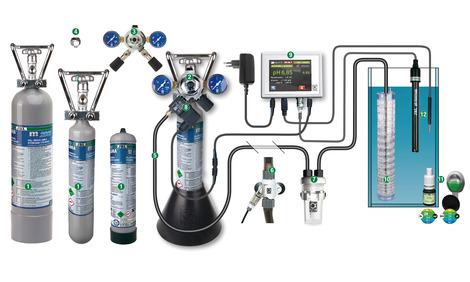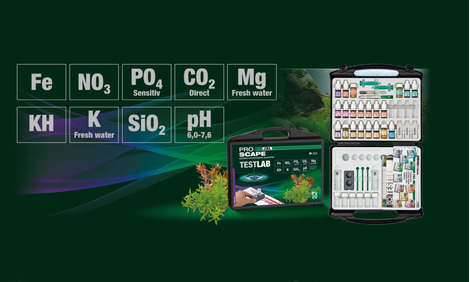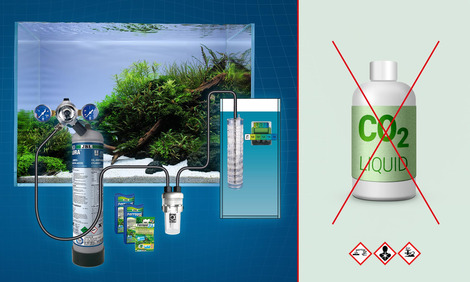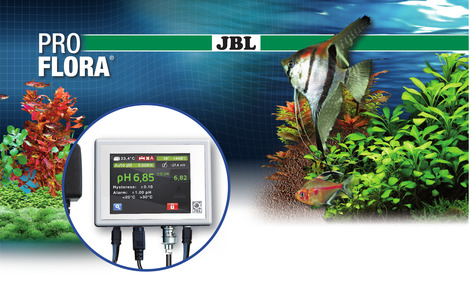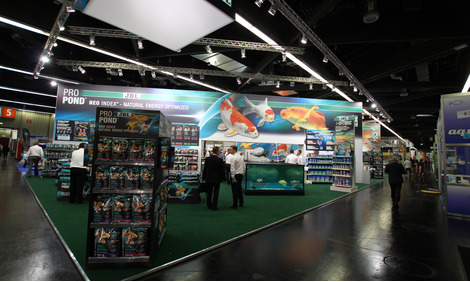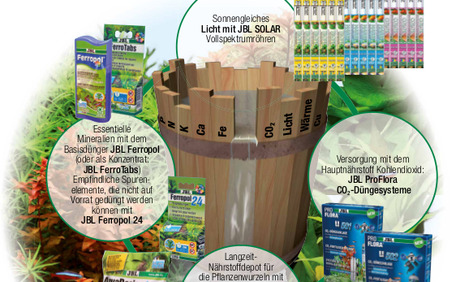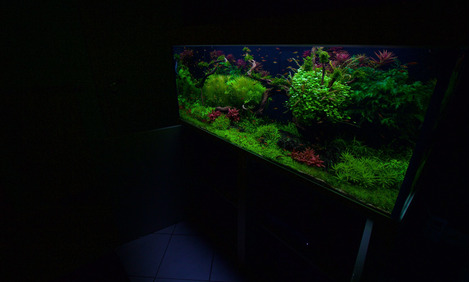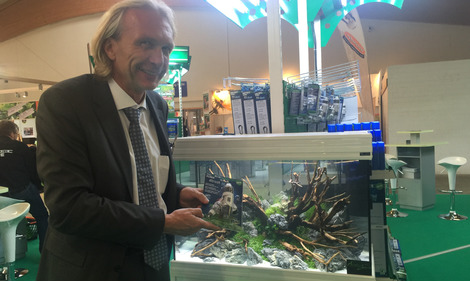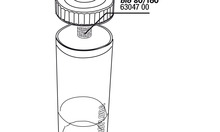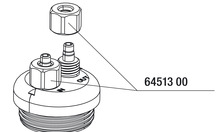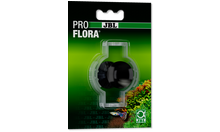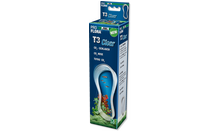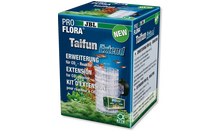Nutrition for aquarium plants
Healthy plants are important in every aquarium. Plants provide the aquarium with vital oxygen for the aquarium inhabitants, prevent algae growth and remove problem-causing substances.
Healthy plants = healthy fish
Healthy plants prevent algae growth, supply oxygen, remove pollutants, offer hiding places and reduce pathogens.
For the plants to flourish the following demands need to be met:
Light as an energy source for the photosynthesis of CO2, nutrients and trace elements to promote growth.
JBL plant fertilisers supply the plants with all their main nutrients and essential trace elements through the water. This way the plants can absorb all the required nutrients they need over the leaves and roots.
JBL PROFLORA Bio160
Bio-CO2 fertiliser system with extendable diffuser
PROFLORA CO2 ADVANCED BIO SET
- Natural CO2 fertilisation for 80 days: healthy plant growth, less algae. Bio-CO₂ starter set for aquariums from 50-160 l
- Simple to install: ready for use within a few minutes
- Natural: CO2 produced in a biological fermentation process. Immediate and long-term buffer system ensures steady production of CO2 for 2 x 40 days, refillable. Improves plant growth in red, fine-structured and sensitive plants. Extendable diffuser
- No pressurised gas cylinder needed, special CO2 resistant hose
- Package contents: bio-CO2 fertiliser system, ProFlora bio 160, incl. reaction canister with thermal casing, 2 x refill set, CO2 diffuser, 3 m CO2 hose, check valve
JBL PROFLORA Bio160
Properties
| Animal species: | Armored catfish, Arowana, Axolotl, Barbels, Bettas, Bichirs/reedfish, Blowfish, Catfish, Cichlids (South America), Clawed frogs, Clawed shrimps, Crayfish, Danions, Discus, Dwarf crayfish, Dwarf shrimps, Flowerhorn, Goldfish, Gouramis, Guppy, Juvenile fish, Killifish, Livebearers, Loaches, Mussels, Panchaxes, Rainbowfish, Snails, Spiny eels, Tetra, Veiltails, freshwater butterflyfish |
| Animal size: | For all animal sizes |
| Animal age group: | All aquarium fish |
| Volume habitat: | 50-160 L |
| Material: | Plastic, nutrient mixture, yeast |
| Colour: | transparent / black |
| Dosage: | see instruction manual |
Electronic label / illuminant
| Mercury: | No |
| Dimmable: | No |
Technical Data
| capacity from - to: | 50-160 |
| capacity in days: | 80 d |
At first the air hoses and special CO2 hoses can easily be pushed on the connection piece. The hoses harden more and more as the months go on and can only be removed from the connection piece using great force. If you pull the hose hard it will only strain the connection, which could, in the worst case, even break off. Instead cut the hoses you want to remove laterally at the ends and carefully remove them. For this it’s always advisable to install hoses with some reserve in its hose length.
The retaining spring in the check valve fits very tightly and ensures that no water can return. Therefore the air pressure of a diaphragm pump or our breath is not strong enough to open the spring. The valve can be opened by the pressure of the ProFlora bioCO2 systems and also the m and u series. Check valves used in air systems have a smaller counter-pressure and are also part of the JBL range.
Algae problems in an aquarium can never be traced to just one factor or general condition, and instead, are always the result of a combination of different factors, which include light, fertilization, water changes – specifically, how often and how much – feeding, fish population and, of course, the specific water parameters.
According to analyses that were performed over a course of a number of years, red algae, at least the common brush algae and beard algae, occur in descending order at the following parameters:
1) too little carbon dioxide (in relationship to 100 % of the measured tank); the pH level should be in the slightly acetic range, depending on the carbonate hardness, in every case.
2) elevated phosphate levels (over 90 %); phosphate limitation by means of JBL PhosEx ultra is often helpful here.
3) too little and too irregular fertilization (there should always be traces of iron at least).
4) insufficient water changes; a weekly water change of over 30 % is recommended for algae problems.
5) not enough fast-growing plants.
The point at which the CO2 fermentation begins depends not only on the room temperature (22.5 °C and above is ideal), but also on the temperature in the reaction vessel and the temperature you started with when creating your new fermentation batch (25°C is ideal). Fermentation normally begins latest after 48 h. If CO2 production still hasn’t occurred, as in your case, you could try adding some more microorganisms. As an alternative, you can also add approx. the same amount of dry yeast.
Cleaning needs to be done by hand. A dishwasher may damage the plastic. Use a washing-up brush, bottle brush or the JBL WishWash instead. JBL PROCLEAN POWER or JBL PROCLEAN AQUA can be used as a cleaning solution to remove coarse dirt beforehand.
Please bear in mind that the microorganisms are sensitive. They need heat for an optimal start and optimal work.
Fill the reaction vessel with approx. 25 °C warm water after adding component 1. Then add the microorganisms and close the reaction vessel. Shake the vessel vigorously, making sure to seal the opening with your finger. Then place the reaction vessel in the Thermobox (applies to ProFlora bio160). After no later than 48 hours, the reaction should have started.
The Taifun P requires pressure for the carbon dioxide to be pressed through the fine membrane. The pressure formed in the reaction flask of JBL bio80 and JBL bio160 is enough to operate the diffuser.
If there are no fine bubbles coming out of the Taifun P, this may be due to the following:
1) The fermentation of the microorganisms isn’t working (see Solutions in the FAQ for the JBL bioRefill).
2) There might be a leak somewhere in the system where pressure can escape. Potential causes of the leak:
2a) The lid of the reaction vessel isn't screwed onto the cylinder properly. Solution: Clean or perhaps replace the sealing ring in the lid.
2b) The connections of the JBL T3 CO₂ hose where it is connected to the cylinder and the JBL SafeStop aren’t fastened tightly. Solution: The hoses must be pushed onto the connections all the way. If used frequently, we recommend shortening the hose by approx. 1 cm.
1. Increase the volume of water changed each week to about 30-50%.
2. Fertilise regularly after each water change, e.g. with JBL Ferropol.
3. If necessary add a daily dose of Ferropol 24.
4. If algae promoting nutrients (especially phosphate) are present in higher quantities, use e.g. JBL PhosEx ultra to keep them under control.
5. Most important is carbon dioxide. Beard and brush algae are always a sign that there is too little carbon dioxide in the water. If a CO2 system is in use, increase its dosage. Alternatively consider installing a CO2 system like JBL ProFlora u401 or m601.
6. Put in fast growing stem plants as nutrient competitors.
7. If there is strong current, reduce it slightly.
During aeration and/or when there is a strong current, a gas equilibrium is achieved between the ambient air and the water. As a result a corresponding but very low CO2 content occurs too. BUT this low CO2 content is far too low to for most aquarium plants to thrive. The aquarium owner is therefore dependent on an additional CO2 supply by a CO2 fertiliser system. The higher CO2 content this achieves is reduced or, as commonly referred to in aquatics, expelled by the aeration and strong current. Therefore well planted aquariums should only be slightly aerated at night, if required.
Reviews
0 Reviews
3 more reviews in other languages
3 Reviews in other languages
Es hilft bei dem Pflanzenwuchs aber bei sehr hoher Bepflanzung reicht es nicht ganz!
Bonsoir, à tous, il y a quelques semaines, j'ai décidé de tester ma première expérience du CO2 dans mon bac de 240 l.
N'ayant pas vraiment eux d'excellents retour sur le CO2 en général, j'ai voulus faire ma propre expérience avec un premier kit qui se trouve être le kit ProFlora Bio 160, il s'agit d'un système artisanal, qui est Super simple d'utilisation et d'installation.
Mes premières bulles de CO2 sont apparues 6 heures après le lancement. Ce qui est assez rapide en sachant que dans le fascicule ils disent qu'il faut une moyen de 24h.
Aux fur et a mesure des semaines, j'ai pût voir mes premiers résultats sur mes différentes plantes, de là, j'ai regardé pour acheter le deuxième kit qui est le ProFlora Bio 80 que j'ai installé en complément.
Le seul bémol a été le diffuseur fournit sur ce kit bio 160 (qui a été remplacé dans le nouveau kit qu'il propose actuellement) que j'ai remplacées assez rapidement par le diffuseur en verre et céramique qui est bien plus performant.
Pour ce qui est de la recharge qui consiste à un mélange de sucre et de levures, j'ai ténu facilement une 60ene de jours, ce qui est pas si mal quand on sait qu'il est conçu pour 40 jours de base.
Voilà, je pense avoir fait le tour de mon ressenti sur mon petit test
Je recommande vivement cette petite gamme qui est assez simple d'utilisation, question budget, il est assez abordable et convient pour les petits budgets.
Je reviendrai dans l'avenir sur le suivi de c'est deux kits.
Leider nur 3 Sterne da die CO2 Ausbeute für ein Aquascape nicht ausreicht.
Aufbau und Handhabung sind sehr leicht.
Tipp: 2 Tage warten, dann kommt das Co2 ins Becken.
Für ein Aquarium mit wenig Pflanzen oder Pflanzen die auch mit weniger Co2 auskommen, eine günstige Alternative zu Druckgas Co2 Anlagen.
